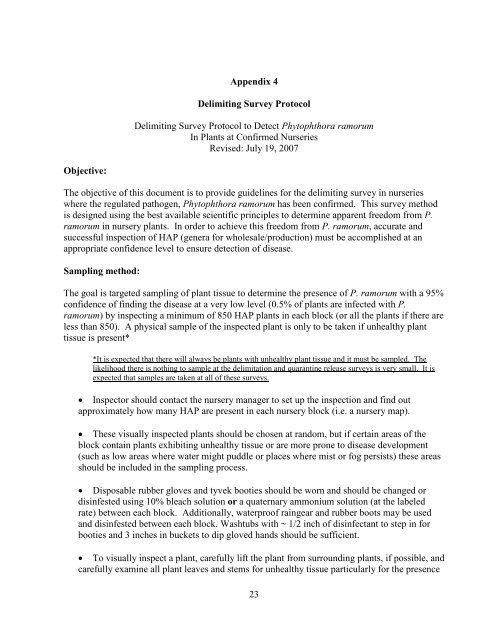Confirmed Nursery Protocol - aphis
Confirmed Nursery Protocol - aphis
Confirmed Nursery Protocol - aphis
Create successful ePaper yourself
Turn your PDF publications into a flip-book with our unique Google optimized e-Paper software.
Appendix 4<br />
Delimiting Survey <strong>Protocol</strong><br />
Delimiting Survey <strong>Protocol</strong> to Detect Phytophthora ramorum<br />
In Plants at <strong>Confirmed</strong> Nurseries<br />
Revised: July 19, 2007<br />
Objective:<br />
The objective of this document is to provide guidelines for the delimiting survey in nurseries<br />
where the regulated pathogen, Phytophthora ramorum has been confirmed. This survey method<br />
is designed using the best available scientific principles to determine apparent freedom from P.<br />
ramorum in nursery plants. In order to achieve this freedom from P. ramorum, accurate and<br />
successful inspection of HAP (genera for wholesale/production) must be accomplished at an<br />
appropriate confidence level to ensure detection of disease.<br />
Sampling method:<br />
The goal is targeted sampling of plant tissue to determine the presence of P. ramorum with a 95%<br />
confidence of finding the disease at a very low level (0.5% of plants are infected with P.<br />
ramorum) by inspecting a minimum of 850 HAP plants in each block (or all the plants if there are<br />
less than 850). A physical sample of the inspected plant is only to be taken if unhealthy plant<br />
tissue is present*<br />
*It is expected that there will always be plants with unhealthy plant tissue and it must be sampled. The<br />
likelihood there is nothing to sample at the delimitation and quarantine release surveys is very small. It is<br />
expected that samples are taken at all of these surveys.<br />
• Inspector should contact the nursery manager to set up the inspection and find out<br />
approximately how many HAP are present in each nursery block (i.e. a nursery map).<br />
• These visually inspected plants should be chosen at random, but if certain areas of the<br />
block contain plants exhibiting unhealthy tissue or are more prone to disease development<br />
(such as low areas where water might puddle or places where mist or fog persists) these areas<br />
should be included in the sampling process.<br />
• Disposable rubber gloves and tyvek booties should be worn and should be changed or<br />
disinfested using 10% bleach solution or a quaternary ammonium solution (at the labeled<br />
rate) between each block. Additionally, waterproof raingear and rubber boots may be used<br />
and disinfested between each block. Washtubs with ~ 1/2 inch of disinfectant to step in for<br />
booties and 3 inches in buckets to dip gloved hands should be sufficient.<br />
• To visually inspect a plant, carefully lift the plant from surrounding plants, if possible, and<br />
carefully examine all plant leaves and stems for unhealthy tissue particularly for the presence<br />
23
















